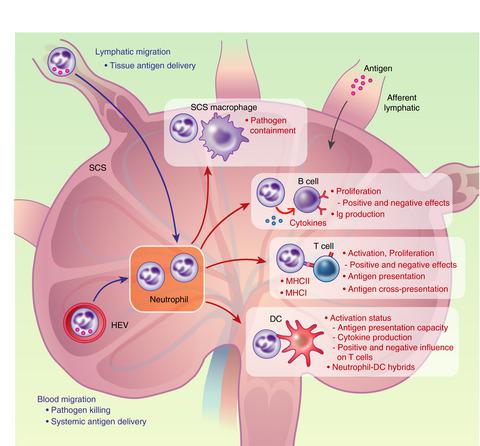当前位置:
X-MOL 学术
›
Immunology
›
论文详情
Our official English website, www.x-mol.net, welcomes your feedback! (Note: you will need to create a separate account there.)
Neutrophils in secondary lymphoid organs
Immunology ( IF 6.4 ) Pub Date : 2021-08-19 , DOI: 10.1111/imm.13406 Laurence S C Lok 1, 2, 3, 4 , Menna R Clatworthy 1, 2, 5
Immunology ( IF 6.4 ) Pub Date : 2021-08-19 , DOI: 10.1111/imm.13406 Laurence S C Lok 1, 2, 3, 4 , Menna R Clatworthy 1, 2, 5
Affiliation

|
Neutrophils are traditionally considered short-lived, circulating innate immune cells that are rapidly recruited to sites of inflammation in response to infectious and inflammatory stimuli. Neutrophils efficiently internalize, kill or entrap pathogens, but their effector molecules may cause collateral tissue damage. More recently, it has been appreciated that neutrophils can also influence adaptive immunity. Lymph nodes (LNs) are immune cell-rich secondary lymphoid organs that provide an ideal platform for cellular interaction and the integration of immunological information collected from local tissues. A variety of peripheral stimuli promote neutrophil migration to draining LNs via blood or lymphatics, utilizing differing molecular cues depending on the site of entry. Within LNs, neutrophils interact with other innate and adaptive cells. Crosstalk with subcapsular sinus macrophages contributes to the control of pathogen spread beyond the LN. Neutrophils can influence antigen presentation indirectly by interacting with DCs or directly by expressing major histocompatibility complex (MHC) and costimulatory molecules for antigen presentation. Interactions between neutrophils and adaptive lymphocytes can alter B-cell antibody responses. Studies have shown conflicting results on whether neutrophils exert stimulatory or inhibitory effects on other LN immune cells, with stimulus-specific and temporal differences in the outcome of these interactions. Furthermore, neutrophils have also been shown to traffick to LNs in homeostasis, with a potential role in immune surveillance, antigen capture and in shaping early adaptive responses in LNs. Understanding the mechanisms underpinning the effects of neutrophils on LN immune cells and adaptive immunity could facilitate the development of neutrophil-targeted therapies in inflammatory diseases.
中文翻译:

次级淋巴器官中的中性粒细胞
中性粒细胞传统上被认为是短暂的循环先天免疫细胞,它们会迅速募集到炎症部位以响应感染性和炎症性刺激。中性粒细胞有效地内化、杀死或捕获病原体,但它们的效应分子可能会导致附带组织损伤。最近,人们认识到中性粒细胞也可以影响适应性免疫。淋巴结 (LN) 是富含免疫细胞的次级淋巴器官,为细胞相互作用和整合从局部组织收集的免疫信息提供了理想的平台。各种外周刺激促进中性粒细胞通过血液或淋巴管迁移到引流淋巴结,根据进入部位利用不同的分子线索。在 LNs 中,中性粒细胞与其他先天和适应性细胞相互作用。与包膜下窦巨噬细胞的串扰有助于控制病原体扩散到 LN 之外。中性粒细胞可以通过与 DC 相互作用间接影响抗原呈递,或通过表达主要组织相容性复合物 (MHC) 和用于抗原呈递的共刺激分子直接影响抗原呈递。中性粒细胞和适应性淋巴细胞之间的相互作用可以改变 B 细胞抗体反应。研究表明,中性粒细胞是否对其他 LN 免疫细胞发挥刺激或抑制作用的结果相互矛盾,这些相互作用的结果具有刺激特异性和时间差异。此外,中性粒细胞也被证明可以在稳态中运输到 LN,在免疫监视、抗原捕获和塑造 LN 的早期适应性反应方面具有潜在作用。
更新日期:2021-08-19
中文翻译:

次级淋巴器官中的中性粒细胞
中性粒细胞传统上被认为是短暂的循环先天免疫细胞,它们会迅速募集到炎症部位以响应感染性和炎症性刺激。中性粒细胞有效地内化、杀死或捕获病原体,但它们的效应分子可能会导致附带组织损伤。最近,人们认识到中性粒细胞也可以影响适应性免疫。淋巴结 (LN) 是富含免疫细胞的次级淋巴器官,为细胞相互作用和整合从局部组织收集的免疫信息提供了理想的平台。各种外周刺激促进中性粒细胞通过血液或淋巴管迁移到引流淋巴结,根据进入部位利用不同的分子线索。在 LNs 中,中性粒细胞与其他先天和适应性细胞相互作用。与包膜下窦巨噬细胞的串扰有助于控制病原体扩散到 LN 之外。中性粒细胞可以通过与 DC 相互作用间接影响抗原呈递,或通过表达主要组织相容性复合物 (MHC) 和用于抗原呈递的共刺激分子直接影响抗原呈递。中性粒细胞和适应性淋巴细胞之间的相互作用可以改变 B 细胞抗体反应。研究表明,中性粒细胞是否对其他 LN 免疫细胞发挥刺激或抑制作用的结果相互矛盾,这些相互作用的结果具有刺激特异性和时间差异。此外,中性粒细胞也被证明可以在稳态中运输到 LN,在免疫监视、抗原捕获和塑造 LN 的早期适应性反应方面具有潜在作用。



























 京公网安备 11010802027423号
京公网安备 11010802027423号